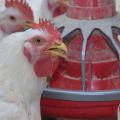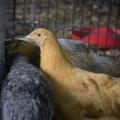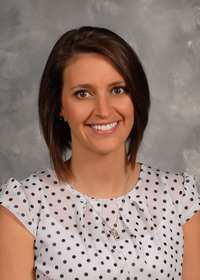Temperatures recommended for brooding quail
The day-old chick's temperature is about 3° F below that of an adult's. Its body temperature starts rising about 4 days of age and reaches its maximum at 10 days. The chick needs time to develop temperature control (2 to 4 weeks). As the chick grows older, the downy coat is replaced with feathers, and brooder temperature must be reduced according tothe temperature schedule.
| Brooding Temperature Schedule | |||
| Age, days | Brooder temperature | ||
| Summer | Winter | ||
| 1-7 | 90º | to | 95º |
| 8-14 | 85º | to | 90º |
| 15-21 | 80º | to | 85º |
| 22-28 | 75º | to | 80º |
| 29-35 | 70º | to | 75º |
| 36 to market | 70º | ||
Under this brooding schedule, the brooding temperature is reduced 5 °F each week. At 5 weeks of age, chicks maintain their own body temperatures if the room temperature is kept near 70 degrees.
Use lower brooding temperatures during warm months. Most poultry houses are not tight enough to maintain these temperatures constantly in winter. Insure adequate warmth in winter by using the higher brooding temperature; when cold nights cool the house, chicks are likely to have enough warmth.
In contrast to what many think, the most frequent error observed when brooding in the South is overheating rather than too little heat. Many producers need to learn proper brooding to reduce losses.
Check the comfort of the chicks several times each day, especially in the evening. Make adjustments to maintain chick comfort. Contented peeping and even distribution of chicks around and under the brooder indicate comfortable conditions. If the chicks chirp and huddle to one side of the brooder, there is a draft. When the temperature is too cold, the chicks chirp sharply and huddle together under the brooder. If the chicks move away from the brooder, pant, and are drowsy, the temperature is too warm.
Publications
News
STARKVILLE, Miss. -- Until an avian flu vaccine for chickens or other alternative is federally approved, commercial poultry operations in the U.S.
STARKVILLE, Miss. -- If egg prices have seemed higher than ever lately, it’s because they are, and consumers can place much of the blame squarely at the feet of the ongoing bird flu outbreak.
With highly pathogenic avian influenza, or HPAI, in the environment in Mississippi, owners of backyard flocks have to take extra steps to keep their chickens healthy.
Avian influenza poses an extremely low risk to human health and none to food safety in Mississippi, but its presence poses a risk to backyard flocks and the state’s $3 billion commercial poultry industry.







